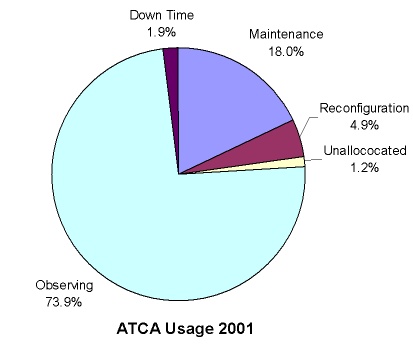Australia Telescope Compact Array report
Staff
As from 1 January, Dave McConnell stepped down as Officer-in-Charge at Narrabri to move to Marsfield permanently. After a brief leave in Bangalore to work on astronomy (and holiday in Nepal), Dave will be continuing in management positions within the ATNF. Ron Beresford has also stepped down as Deputy Officer-in-Charge to move to Marsfield. Ron will work within the Electronics Group and on SKA developments. Bob Sault has moved from Marsfield to take over Dave's position, on a five-year appointment. We all thank Dave and Ron for their long service at Narrabri, and we look forward to their continuing but different involvement with the ATCA in the future. I [Bob Sault] in particular appreciate Dave's and Ron's advice and help in starting my new position here.
After many years providing sterling service at the Lodge to both visitors and staff, Chris Forbes quietly resigned just before Christmas. We will miss her lively presence in the lodge. Shaun James, from the electronics group, also resigned before Christmas, to take up a position with the AAT at Siding Springs. Hopefully we will continue to maintain contact with both Chris and Shaun.
We welcome Derek Aboltins, who started with us in December, and is working with Allan Day in the cryogenics area. Allan Day, in turn, has recently returned from two months at the South Pole working with the DASI group. Euan Troup (formerly from the ATNF at Parkes) has returned to the ATNF, but at Narrabri, after a three-year period working in Jodrell Bank. Euan will be working in the computer group, converting the observing software from a VMS to LINUX environment. We also welcome Crystal Gay, who has started with us as an assistant to Kylee Forbes in the Administration section. Crystal will, in part, help fill the gap while Anni Reynolds is away on maternity leave.
Congratulations to Alison Ryan on completing her apprenticeship with the ATNF. Alison is continuing with us in the short term, working on finishing the fibre optics splicing for the MNRF-I upgrade.
Visitors
In November, the ATCA was visited by Robin Batterham (Australia's Chief Scientist), Martin Cole (President, Institute of Engineers) and Peter Jonson (Chairman, Melbourne Institute). These visitors showed a keen interest in our operation and our place in Australia's fundamental science research.
We have hosted two vacation scholars this year - Nicolai Grosse and Vicki Safouris, who have been diligently working by day on projects involving gamma-ray loud AGN and the warm interstellar medium, and at night on cello and piano recitals. We have also hosted an observing project visit from a contingent of ATNF and CTIP vacation scholars, who observed h Carina with the new 12-mm system (see article elsewhere in this issue), observed new HIPASS galaxies, and studied interference from microwave ovens.
Operations
In addition to the previously advertised configurations, in the May 2002 term we plan to schedule the new EW214 and H75 configurations. The scheduling of H75 will be the first observations to use the north spur.
Array usage
Figure 1 gives the usage of the compact array during calendar year 2001. We have started to accumulate statistics on millimetre usage. During the last term, scheduled millimetre observing time was affected by a cryogenics failure, late installation of some hardware in the 12-mm system and by the usual bad weather.

Figure 1: Compact Array usage for 2001
User feedback
Table 1 is compiled from questionnaires completed by observers. The ranking is from one to five, with five being the best score.

Table 1: User feedback for 2001
MNRF-I update
Antenna control computers
All the low level control code for the ACCs (pSOS code) has now been written and an integrated system for servo, cycle, datasets and host control is available. Currently we are testing this system with a single antenna. Preliminary indications are good; the correlator shows a normal autocorrelation spectrum, which changes as we move the antenna around the sky. Control is done from an adapted version of CAOBS that talks to a java interface that in turn communicates with the antennas. The coming months will be occupied with further testing, debugging and fine tuning of the interface with CAOBS. We now have the hardware to run two antennas under new ACC control, so a major goal will be a working interferometer.
Antenna structure
Following successful testing on an antenna in Marsfield, a survey of an ATCA antenna will be done using photogrammetry in mid-February. This will allow us to measure the deformation and movement of the main surface, the subreflector quadrapod, the subreflector itself and the receiver package as a function of elevation. The photogrammetry is in addition to a series of measurements on beam patterns at 3 mm, and a comparison of these with theoretical beam patterns of antennas with various imperfections.
Receivers
The interim 3 and 12-mm receiver packages are now available on three antennas. The 12-mm system includes noise diode calibration, whereas the 3-mm system uses a room temperature paddle (a hot load) that can be switched in under computer control. It is envisaged that there will be no significant enhancements to this during 2002. The next major changes will be when the final systems start to be delivered in 2003.
Signal distribution
Steady progress is being made on the new antenna signal distribution network, with the optic fibre patch panel due to be completed in mid-February, and station posts being modified as needed by the reconfiguration schedule.
Time assignment information
Very important information on time assignment issues (Australia Telescope Compact Array upgrades, Array configurations and shuffling, and flexible scheduling) for the coming ATCA terms can be found elsewhere in this issue.
Bob Sault
Officer-in-Charge
(Bob.Sault@csiro.au)
